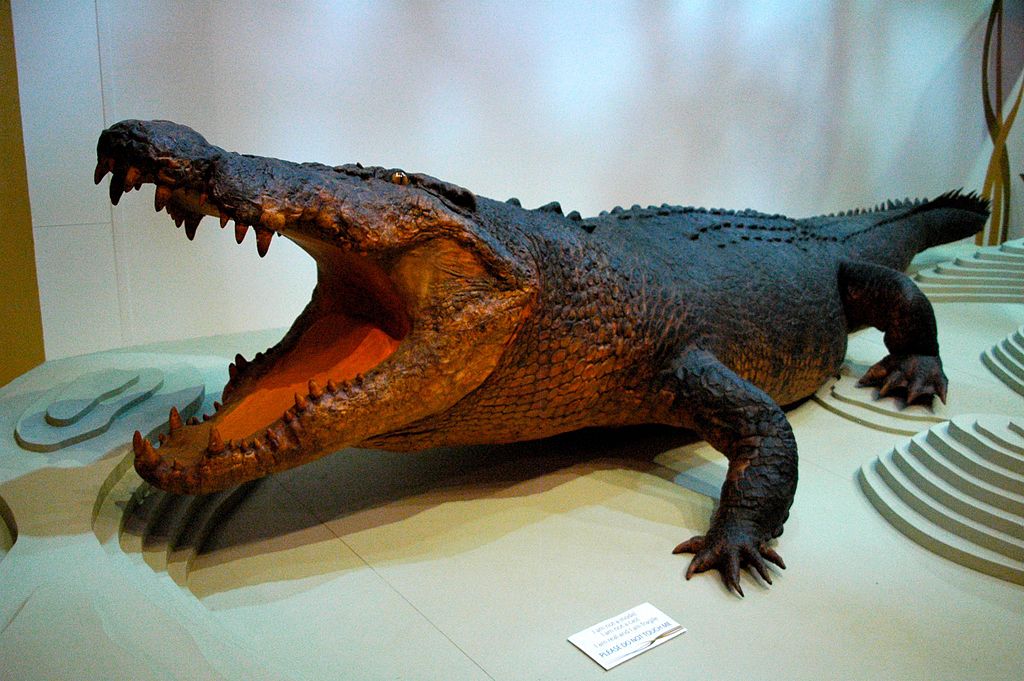From Bali to Darwin | Complete Guide to Visit Darwin and Surroundings
Darwin is the capital of the Northern Territory region of Australia, of which it is also the most populous city. From Bali to Darwin is only 2 hours 30 minutes by airplane. Located on the Timor Sea, in the very north of the island, a regional economic center with its 150,000 inhabitants, it was first a colonial outpost before becoming, over the course of its history, one of the most modern cities, a thriving and cosmopolitan Australian continent. The place is not lacking in character: Darwin is famous for being the city with the most lightning storms worldwide, but also… the city with the most accidents involving saltwater crocodiles, monstrous reptiles that can reach seven meters in length and weigh almost a ton!
From Sydney to Darwin takes 4h 30mn by plane; airlines: Virgin Australia, Jet Star and Qantas.
A university city, young and urban, it is among the Australian capitals the one with the highest proportion of Aborigines: they had moreover set up trade routes between Southeast Asia and South Australia, long before the arrival of the first European settlers.
Wondering what to do in Darwin during your stay? Here is the answer with our essentials to visit Darwin and enjoy your visit without missing a beat!
From Bali to Darwin direct flights
Ngurah Rai (DPS) to Darwin (DRW) flights
The flight time between Ngurah Rai (DPS) and Darwin (DRW) it takes around 2h 30m and covers a distance of around 1764 km (1096 miles). Services are operated by Jetstar. Typically six flights run weekly, although weekend and holiday schedules can vary so check in advance.
Read also: International Direct Flights to Bali
1. Darwin Waterfront
This is the place that can satisfy all those looking for relaxation: large lawns for sunbathing, palm trees and a lagoon pool with waves… If you are lucky, you can even attend a session of open-air cinema or take part in a Tai Chi class in the morning!
One of the most pleasant waterfront areas in Australia is located in the heart of Darwin, 5 minutes walk from the city center. Take a wave in the very popular hot tub, swim in the saltwater lagoon, relax in one of the colorful cafes, taste a craft beer in the tavern, enjoy a good meal in one of the many restaurants or sit in the shade in the lush green grounds. Then visit the attractions of nearby Stokes Hill Wharf, with fabulous views across Darwin Bay.

Darwin Waterfront Precinct. Alex Healing, CC BY 2.0, via Wikimedia Commons
2. Smith street and its Aboriginal art shops
Located in the heart of the city centre, Smith Street is a charming and lively shopping street: it is Darwin’s authentic artery! Its tourist attraction is linked to the massive presence of traditional stalls presenting handicrafts created by the aborigines, who are very numerous in the city. Why not visit it when you come to visit Darwin?

Darwin (AU), Parliament House (Legislative Assembly of the Northern Territory), Near Smith streetand Darwin Waterfront Precinct. Address: 15 Mitchell St, Darwin City NT 0800, Australia. Kgbo, CC BY-SA 4.0, via Wikimedia Commons
The communities come to sell souvenirs and picturesque accessories, sometimes made of surprising materials – kangaroo hair, or crocodile skin! Many small gastronomic establishments serve a varied and delicious food and the place will certainly delight young and old.
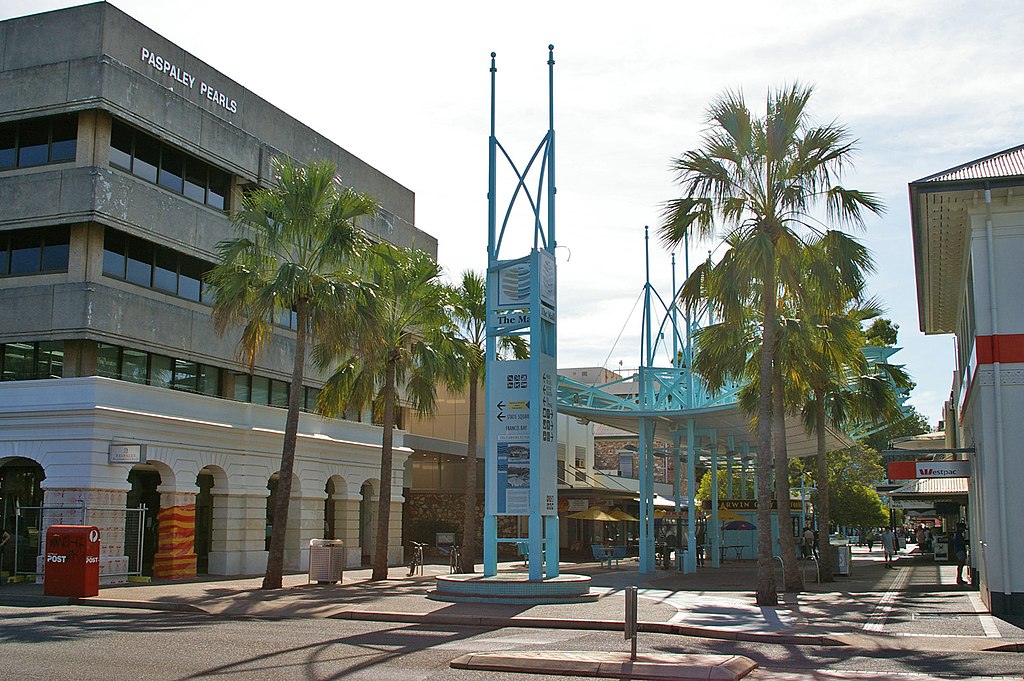
Smith Street Mall. Bidgee, CC BY 3.0, via Wikimedia Commons
3. Crocosaurus Cove
What to do in Darwin when you like to shiver? The Crocosaurus Cove is an animal park dedicated to reptiles, stars of the area. Interactive, it offers many workshops that will appeal to the little ones, and presents the different characteristics of crocodiles, lizards, turtles, the last descendants of dinosaurs! Guided tours can be enjoyed in several languages and, for the more adventurous, a one-of-a-kind attraction is offered: immersion in a cage in a pool with… a sea crocodile, a gigantic and frightening mastodon!
And if you are particularly fond of crocodiles, why not take the “crocodile jumping” cruise on the Adelaide River, another must-see in Darwin? You can observe wild crocodiles in their natural habitat and see them jump out of the water to catch meat hanging from a fishing rod!

Young saltwater crocodiles at Crocosaurus Cove, Darwin. Mutante, CC BY-SA 3.0, via Wikimedia Commons
4. The Museum and Art Gallery of the Northern Territory
The Museum and Art Gallery of the Northern Territory (MAGNT) is a cultural space not to be missed for anyone who wants to visit Darwin; located in the inner suburbs of the city, at Fannie Bay, it is one of the largest museums on the Australian continent, and an essential tourist stop.
It presents the specificity of aboriginal culture, the rites and customs of this very special people, but also their fascinating ability to live in harmony with nature. Along the paths, discover the boats that allowed the first settlers to land on the island, then the animal species specific to the country, and in particular the famous crocodile Sweetheart, which had the particularity of attacking boats which had the misfortune to cross his path! MAGNT website: https://www.magnt.net.au
Sweetheart the crocodile at Museum and Art Gallery of the Northern Territory (MAGNT), Darwin, Australia. Jpatokal, CC BY-SA 3.0, via Wikimedia Commons
5. George Brown Darwin Botanic Gardens
A favorite that is really worth it for anyone who wants to visit Darwin: the George Brown Darwin Botanic Gardens is an unmissable stop, a well-deserved break within a 42-hectare nature reserve highlighting the local tropical flora, countless varieties of flowers as well as one of the most beautiful orchid greenhouses in the world.
In addition, the visit is very pleasant because the heat is absorbed by the lush vegetation, and this space promises to be a must for those who are still looking for what to do in Darwin. Oh, and don’t forget to try one of the delicious tropical fruit muffins sold in the shaded aisles!

Fountain in the George Brown Darwin Botanic Gardens. Stephen Michael Barnett, CC BY 2.0, via Wikimedia Commons
6. Darwin Military Museum
Did you know? During World War II, the city of Darwin was bombed 64 times in the space of two years! Inevitably, the conflict marked the collective memory of the inhabitants hard and the Darwin Military Museum, created by the association of Australian gunners, now serves as a place of remembrance.
It is very popular with students and college classes in the country, as well as with passing visitors who come to discover period photographs, as well as multiple objects, each with their own history. Ready to take the leap into history? Come and visit Darwin through this memorial!
Entrance to the Darwin Military Museum. MorePix, CC BY-SA 4.0, via Wikimedia Commons
7. Leanyer Recreation Park
Coming to Darwin with your family, with your children? Or, if you haven’t lost your child’s soul, go to the Leanyer Recreation park and its gigantic slides to cool off during the hot days of the southern summer. For young and old, the place is a bubble of freshness in this northern territory known for the harshness of its summer temperatures.
If you don’t know what to do in Darwin, know that it is very busy during the weekend, where locals come to have fun. So prefer to go there during the week to avoid the queue and the wait specific to the most popular amusement parks.
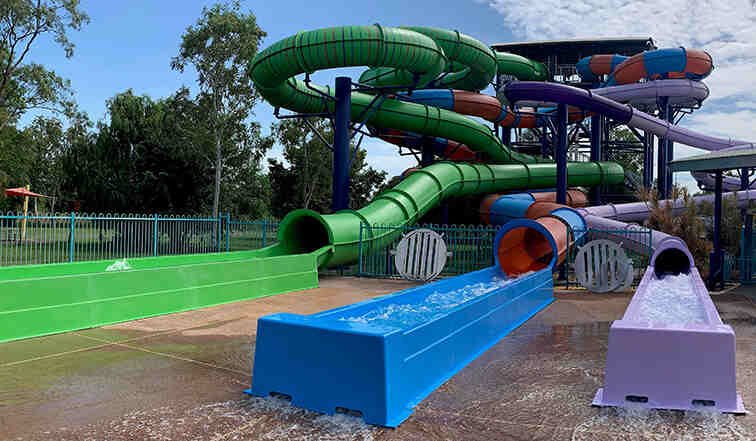
8. Do as the locals do – Go to the market!
What to do in Darwin when you like… to do nothing? It’s very simple: go through Mindil Beach during your stay! This beach, located near the city’s business district, is a popular place for locals who come to relax with their families and do their shopping.
You should know that Mindil Beach is home to a small picturesque market, open during the dry season (April to October), which has the particularity of being open until sunset… which you can admire, once your purchases have been made. , sitting on the beach. The place is popular with lovers and all romantics who come to visit Darwin.
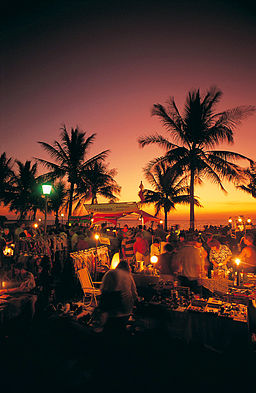
Mindil beach market, Darwin. Tourism NT (Image gallery Tourism NT), Attribution, via Wikimedia Commons
Find locally made treasures and tantalize your taste buds at Darwin’s famous open-air ‘markets’. At the Mindil Beach Sunset Market (Thursdays and Sundays, April to October), sit down at the beach with a snack from one of the market’s 60 stalls, to watch a fiery sunset dip into the ocean. Every weekend, the suburbs of Nightcliff, Parap, Rapid Creek, Palmerston, Coolalinga and Malan transform into open-air markets where residents buy their fruits and vegetables, and feast on laksa (spicy noodle soups) and fresh fruit juices.
9. East Point Reserve
Locals love this place. Located next to the Military Museum, you can access it by bike to stroll through the 200 hectares (494 acres) of trails!
East Point played an important role in protecting Australia during World War II. Visit the Darwin Military Museum to see images of Darwin’s World War II bombings, its photographic and informational exhibits, and explore the turret enclosure. The East Point Reserve is home to abundant wildlife, so take a walk in search of wallabies, bandicoots, brushtail possums and many species of reptiles, butterflies and birds. the 30 minute loop from the parking lot near the lake through the monsoon vine forest in the mangroves. Follow the walk in the tidal region – look for many species of fish, crustaceans and molluscs.
East Point Reserve has several popular beaches, including Darwin’s most popular family beach at Fannie Bay. Lake Alexander draws its seawater from the bay, for safe, sting-free swimming year-round.
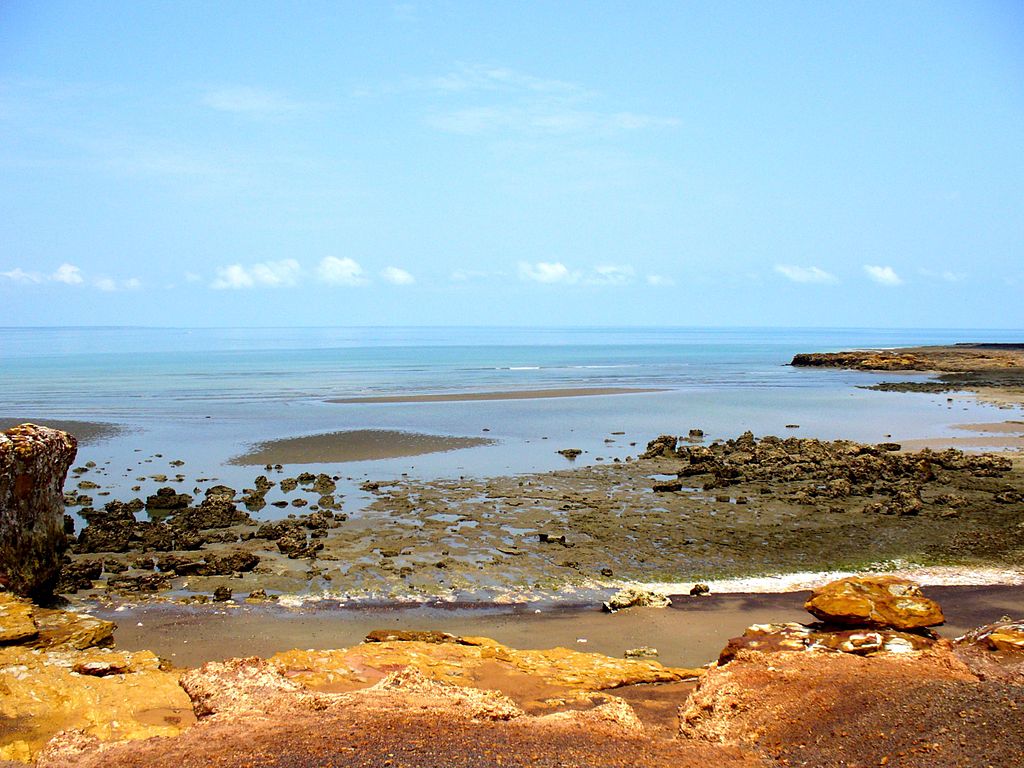
East Point Reserve, Darwin, Australia. yeowatzup, CC BY 2.0, via Wikimedia Commons
10. Bicentennial Park
Bicentennial Park perched on the cliffs of Darwin Harbor along the Esplanade, Bicentennial Park is a good place to catch a sea breeze or spend an afternoon following the WWII walking trail picnicking or relaxing. relax in the open grasslands.
Stretching along Darwin’s waterfront overlooking Darwin Harbor and shaded by tropical trees, the park is a great place to stroll.
Be sure to visit the Cenotaph, Darwin’s first war memorial commemorating Australians who lost their lives in World War I, as well as Aboriginal men and women whose skills in the bush helped the army during the war. World War II to protect the remote north coast. See Darwin’s tribute to the 200 Remarkable Territories – hand-painted tiles on panels dotted along the Esplanade commemorate some of the Territory’s ‘quiet achievements’, including pioneers, publicans and pastors.
To get away from the activity of the city. Very pleasant park where you can rest while contemplating the seafront. World War II memorial at the end of the park near the Parliament.
The park stretches from the Parliament of the Northern Territory to Doctor’s Gully. It is the site of large gatherings such as memorial services and Greek Glentis, but is also perfect for a game of footy, whatever the code. There is a network of shared trails that provide access to areas such as Lameroo Beach and the northwest end, where Doctor’s Gully fish feed.

Bicentennial Park. yeowatzup, CC BY 2.0, via Wikimedia Commons
Darwin and Surroundings
Sail across the bay from Darwin to the Tiwi Islands, glide through the swamps in an air boat to encounter local wildlife, or cool off under a waterfall in Litchfield National Park; you’ll be spoiled for choice in and around Darwin, and you’ll love discovering the many facets of this very special region.
The prosperous and welcoming capital of the Northern Territory, Darwin attracts travelers from all over the world, who come to enjoy its tropical and relaxed lifestyle.
With its waterfront restaurants, crocodile-spotting tours, moving heritage and easy access to the charming Tiwi Islands, there’s plenty to do in Darwin for a weekend or for an extended stay.
Litchfield National Park
Litchfield National Park is just an hour and a half from Darwin by car and is a local favorite all year round. You can easily enjoy it for a day, but with all these swimming spots and beautiful waterfalls, it is definitely worth spending the night nearby. It is a sensational natural water theme park where you can enjoy waterfalls, rock pools and hiking trails, and all less than an hour and a half from Darwin!
Located 130 km south of Darwin, you can visit it in one day. If you want to stay longer, several campsites have been set up there and the nights under the stars will be very pleasant.

Termite buildings in the Litchfield National Park, in Northern Territory Australia. Termites are derived from the Termitidae species. The hills reach heights of up to 7 meters. W. Bulach, CC BY-SA 4.0, via Wikimedia Commons
Litchfield National Park is totally free. You will find waterfalls, natural pools where you can swim safely (respect the warning signs), hiking. It is also an opportunity to meet kangaroos, snakes, spiders, bats, crocodiles in their wild state. The main points of interest are: Magnetic Termite Mound, Florence, Wangi and Tolmer Falls.

Wangi Falls view from boardwalk in the evening. Litchfield National Park, NT Australia. Possibly Litchfield’s most popular attraction, Wangi Falls is easily accessible and open all year round. However, swimming is not always possible due to water levels from heavy rain. Ovico, CC BY-SA 4.0, via Wikimedia Commons
Berry Springs Nature Park – A real little nature paradise just 40 minutes from Darwin!
These are natural hot springs located 60km from Darwin (free). There are three pools. It’s very family-friendly. It has toilets, barbecues and free showers. Ideal for spending a day there and having a picnic with friends.

Mid-afternoon at one of the natural pools at Berry Springs, about 60km from Darwin. A family-friendly place in a natural setting. Jessica.Oreilly, CC BY-SA 4.0, via Wikimedia Commons
Experience Aboriginal culture on the Tiwi Islands
Take a day trip to the picturesque Tiwi Islands, 30 minutes by plane or 2.5 hours by ferry north of Darwin, to share the strong bond of the Tiwi Aboriginal people with their rich culture. Meet local artists at the arts centers on the islands and experience a traditional “smoking ceremony”. If you can, go in March to attend the annual football grand finale and art sale, a very popular and very special event.

Tiwi Islands Car Ferry, 2011, seen from Wurrumiyanga on Bathurst Island across Apsley Strait to Melville Island. Satrina Brandt, CC BY-SA 3.0, via Wikimedia Commons
Ngaruwanajirri Aborigin Art Center, on Bathurst Island (opposite Tiwi Island)
Aboriginal and Torres Strait Islander cultural aspirations and expressions, Ngaruwanajirri Incorporated is an arts centre at Wurrumiyanga on Bathurst Island. Ngaruwanajirri, which means ‘helping one another’ in Tiwi, was established in 1994.
It was originally set up for disabled Tiwi residents but now includes all artists, with the original artists working with traditional wood carvers. Art created includes natural ochre paintings on paper and canvas, batik on silk, lino prints on paper and fabric and ironwood carvings. Many paintings and carvings from Ngaruwanajirri, including tutini poles for Pukumani ceremonies, have been exhibited in Darwin, interstate and overseas. Works reside in private collections and art galleries both nationally and internationally.
Location
The Keeping House, Wurrumiyanga, Bathurst Island
Opening Hours
Monday to Friday 8 am to 12 pm, or by appointment.
Contact
Phone: 08 8978 3724 or 0437 783 724
Email: ngaruwanajirri.inc@bigpond.com
Website: https://tiwilandcouncil.com/index.cfm?fuseaction=page&p=278
 Ceiling of a Tiwi Island art gallery and studio. Satrina Brandt, CC BY-SA 3.0, via Wikimedia Commons
Ceiling of a Tiwi Island art gallery and studio. Satrina Brandt, CC BY-SA 3.0, via Wikimedia Commons
Kakadu National Park
Located 250 km from Darwin (ony 1h 40 mn drive), Kakadu National Park is Australia’s largest national park. Listed as a UNESCO World Heritage Site. Admission is $40 per person.

The largest waterfall in the park, Jim Jim Falls. Tourism NT (Image gallery Tourism NT), Attribution, via Wikimedia Commons
This park is endowed with an incredible richness both by the beauty of its flora, fauna and the aboriginal art that can be admired there. To access the entire park you need a 4×4 since some roads are not accessible to vans or cars.
Main points of interest: Twins Falls, Jim Jim Falls, Nourlangie Rock, Ubirr.

Nourlangie Rock. Tourism NT (Image gallery Tourism NT), Attribution, via Wikimedia Commons
The park has been listed as a World Heritage Site since 1981. The site has been continuously inhabited for more than 40,000 years and contains remains of hunters and fishermen from the Neolithic period to the present-day Aborigines. It presents a history of techniques and behavior illustrated by paintings. Moreover, it concentrates on itself all of the Australian landscapes (with the exception of the arid zones which cover 80% of the territory).

Kakadu Escarpment. Tourism NT (Image gallery Tourism NT), Attribution, via Wikimedia Commons
How to get to Darwin?
Darwin has an international airport which is located in the suburbs of Marrara 13 kilometers north of the center of Darwin. The air network remains the best solution to get to this remote place, and our partner Skyscanner will allow you to find a flight at preferential rates. From Charles de Gaulle airport, your trip will be punctuated by at least one stopover (very often in Singapore) and should take you at least 19 hours!
In addition, the modern and efficient infrastructures (several railway lines ensuring the south/north link with the rest of the Australian territory, a tram, as well as a road network of excellent quality but not very dense) make it possible to vary the means to get to the city, and, once there, to visit Darwin easily. For more autonomy in your stay, you can also rent a car at Darwin airport.
Where to stay in Darwin?
Darwin is a good-sized city that offers several types of accommodation, each with their own advantages, to choose from according to your profile as a traveler who has come to visit Darwin. For a typical and family accommodation, choose without hesitation the many guest houses, in the center and outside the city, run by authentic and warm Australians.
Members of the junior clientele will appreciate the many youth hostels, very widespread in Australia (the destination being popular with young backpackers, or seasonal workers), while those with a comfortable budget will opt for a room in the neighborhood from the city center and its typically Australian wide alleys: you can also find the hotel of your dreams in Darwin by carrying out a search on this hotel comparator. And if you prefer a flexible and affordable solution, opt for an Airbnb accommodation, in order to benefit from a pied-à-terre (a small living unit) that suits you and makes you feel at home. Finally, our article on the best areas to stay in Darwin should also help you!
Now you know how to best enjoy when you come to visit Darwin, and the charms of this special region during your stay. But will you be able to choose what to do in Darwin and… will you prefer to go there in winter, or in summer?
Read also: From Bali To Raja Ampat (4 Kings) | Complete Guide to Visit West Papua
Sources: CleverlySmart, Tourism NT, Tourism Australia, Sightseeing Tours Australia
Photo credit (main picture): yeowatzup, source: Bicentennial Park, Darwin, Australia via Wikimedia Commons
NB: Prices and opening hours of attractions are subject to change without prior notice.
Photo description: Bicentennial Park, Darwin, Australia.
Discover the Ultimate Comfort: Book Your Villa in the Heart of Seminyak Center Today!


